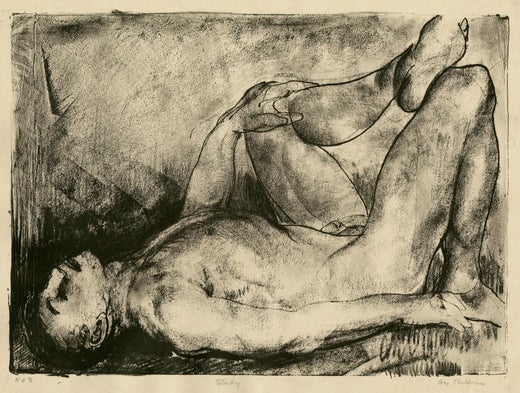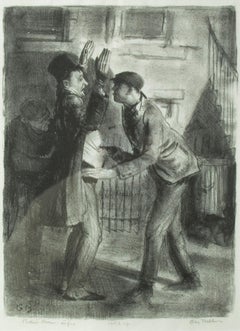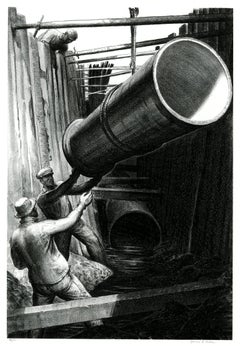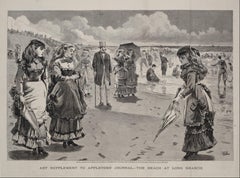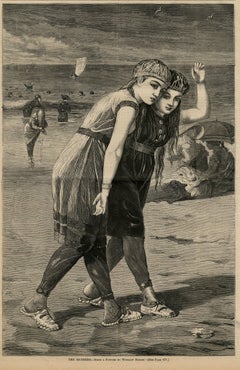Want more images or videos?
Request additional images or videos from the seller
1 of 7
George Wesley BellowsThe Hold Up, First State1921
1921
$7,500List Price
About the Item
- Creator:George Wesley Bellows (1882-1925, American)
- Creation Year:1921
- Dimensions:Height: 11 in (27.94 cm)Width: 8.5 in (21.59 cm)
- Medium:
- Movement & Style:
- Period:
- Condition:Housed in the original H. V. Allison frame, with provenance labels on reverse.
- Gallery Location:Fairlawn, OH
- Reference Number:Seller: FA106271stDibs: LU1405675111
George Wesley Bellows
George Bellows, an American artist, was born in Columbus, Ohio in 1882, the only child of a successful building contractor from Sag Harbor, New York. He entered Ohio State University in 1901, where he played baseball and basketball and made drawings for college publications. He dropped out of college in 1904, went to New York, and studied under Robert Henri (American, 1865 – 1929) at the New York School of Art, where Edward Hopper (American, 1882 – 1967), Rockwell Kent (American, 1882 – 1971), and Guy Pène du Bois (American, 1884 – 1958) were his classmates. A superb technician who worked in a confident, painterly style, Bellows soon established himself as the most important realist of his generation. He created memorable images of club fights, street urchins swimming in the East River, and the Pennsylvania Station excavation site and garnered praise from both progressive and conservative critics. In 1910 Bellows began teaching at the Art Students League and married Emma Story, by whom he had two daughters. After 1910 Bellows gradually abandoned the stark urban realism and dark palette characteristic of his early work and gravitated toward painting landscapes, seascapes, and portraits. Bellows helped organize the Armory Show in 1913, in which five of his paintings and a number of drawings were included. That year he was elected a full member of the National Academy of Design. He had leftist political views and contributed illustrations to the Socialist publication The Masses from 1912 to 1917. Bellows began to make lithographs in 1916 and his exceptional talent engendered a revival of interest in the medium. He worked in Maine, in Carmel, California, and in Middletown, Rhode Island, and was a founding member of the Society of Independent Artists and a charter member of the Association of American Painters and Sculptors. In 1919 he taught at the Art Institute of Chicago. Bellows, who never went to Europe, is regarded as a quintessential American artist whose vigorous style enabled him to explore a wide range of subjects from scenes of modern urban life to portraits of his daughters, to turbulent Maine seascapes. As an early biographer noted, Bellows “caught the brute force of the prizefighter, the ruggedness of the country pasture, the essence of childhood and recorded them appropriately not only for his own generation but for all time.”[1] [1] [Frederick A. Sweet], George Bellows: Paintings, Drawings and Prints (Art Institute of Chicago, IL, 1946). Robert Torchia September 29, 2016
About the Seller
5.0
Recognized Seller
These prestigious sellers are industry leaders and represent the highest echelon for item quality and design.
Gold Seller
Premium sellers maintaining a 4.3+ rating and 24-hour response times
Established in 1978
1stDibs seller since 2013
834 sales on 1stDibs
Associations
International Fine Print Dealers Association
Authenticity Guarantee
In the unlikely event there’s an issue with an item’s authenticity, contact us within 1 year for a full refund. DetailsMoney-Back Guarantee
If your item is not as described, is damaged in transit, or does not arrive, contact us within 7 days for a full refund. Details24-Hour Cancellation
You have a 24-hour grace period in which to reconsider your purchase, with no questions asked.Vetted Professional Sellers
Our world-class sellers must adhere to strict standards for service and quality, maintaining the integrity of our listings.Price-Match Guarantee
If you find that a seller listed the same item for a lower price elsewhere, we’ll match it.Trusted Global Delivery
Our best-in-class carrier network provides specialized shipping options worldwide, including custom delivery.You May Also Like
Greta Garbo Swedish American Movie Film Star Goddess Hollywood Mid 20th Century
By Albert Al Hirschfeld
Located in New York, NY
Greta Garbo Swedish American Movie Film Star Goddess Hollywood Mid 20th Century
Al Hirschfeld (1903-2003)
Greta Garbo
Plate Size: 13 7/8 x 9 3/4
Paper Size:...
Category
1980s American Realist Figurative Prints
Materials
Lithograph
Meditation and Minou
By Will Barnet
Located in Buffalo, NY
Artist: Will Barnet, American (1911 - 2012)
Title: Meditation and Minou
Year: 1980
Medium: Lithograph and Serigraph on BFK Rives, signed and numbered in pencil
Edition: 40/150
Category
1970s American Realist Figurative Prints
Materials
Archival Paper, Lithograph
Reflections
By Will Barnet
Located in Buffalo, NY
“Reflection, 1971”
Medium: Color serigraph
Signed and titled
Ed: 121/225
Sheet: 30 x 23 in.
Image: 22 x 14.5 in.
Condition: Excellent
Category
1970s American Realist Figurative Prints
Materials
Archival Paper, Lithograph
Destination Unknown, Ernie Barnes
By Ernie Barnes
Located in Fairfield, CT
Artist: Earnie Barnes (1938-2009)
Title: Destination Unknown
Year: 1979
Medium: Lithograph on archival paper
Size: 25 x 19.5 inches
Edition: 120/300, plus proofs
Condition: Good
Insc...
Category
1970s American Realist Figurative Prints
Materials
Lithograph
Original Historic Carlisle - Gateway to Scotland vintage railroad poster
Located in Spokane, WA
Original British vintage poster: Historic Carlisle - Gateway to Scotland. Artist: Maurice Greiffenhagen. Horizontal size 39" x 48.75". Archival linen-backed original stone lithograph; ready to frame. In very good to excellent condition.
Original, 1925 horizontal travel by train stone lithograph. Historic Carlisle ~ 800 years of Civic Independence. See Britain by train. British Railways. Published by British Railways (London Midland Region) LM 16657.
Probably the most famous British railway poster of the 1920s. The LMS commissioned designs from 16 leading Royal Academicians in 1924, of which this was by far the most popular.
A British Royal seal...
Category
1920s American Realist Figurative Prints
Materials
Lithograph
$2,760 Sale Price
20% Off
H 48.75 in W 39 in D 0.05 in
Original Fiestas de Primavera Murcia - Spain vintage lithograph poster
Located in Spokane, WA
Original poster: FIESTAS DE PRIMAVERA MURCIA. Ani 1953.
Linen-backed, very good condition. Lithograph.
The Spring Festivals are celebrated in Murcia the week after Easter. Thes...
Category
1950s American Realist Figurative Prints
Materials
Lithograph
$359 Sale Price
20% Off
H 33.75 in W 24 in D 0.05 in
Original Your Country Needs You! Join the Navy Now! vintage WW1 poster
Located in Spokane, WA
Original WW1 poster: "Your Country Needs You! Join the Navy Now!"
Original poster printed by the U.S. Food Administration during World War One. Archi...
Category
1910s American Realist Figurative Prints
Materials
Lithograph
$1,000 Sale Price
20% Off
H 25 in W 19 in D 0.05 in
Original "Be Patriotic sign your country's pledge to save the food" poster
Located in Spokane, WA
Original WW1 poster: "Be Patriotic sign your country's pledge to save the food." U. S. Food Administration. Miss Liberty calls with outstretch...
Category
1910s American Realist Figurative Prints
Materials
Lithograph
$595
H 29 in W 21 in D 0.05 in
Original "Food Will Win The War" vintage World War 1 poster
By Charles E. Chambers
Located in Spokane, WA
Original World War 1 vintage poster: Food Will Wn the War. Arhival linen backed. PRINTER: Rusling Wood Litho., New York Bright and in good condition. There is some marks down the left side of the poster, possible ink from when the poster was printed.
This poster calls on immigrants to do their part in the war effort. It depicts recent immigrants standing near a sailing ship with the Statue of Liberty and a rainbow stretched across the New York City skyline in the background. The text reads:
You came here seeking Freedom.
You must now help preserve it.
Wheat is needed by the allies.
Waste nothing.
The generosity and compassion of the American people and the great agricultural resources of the North American continent would be called upon... Twenty million Americans signed pledges of membership in the Food Administration...
Category
1910s American Realist Figurative Prints
Materials
Lithograph
$1,100
H 30 in W 20 in D 0.05 in
Original Patriotic League vintage poster Christy Girl
By Howard Chandler Christy
Located in Spokane, WA
Original vintage poster: Patriotic League . Original Howard Chandler Christy's 1918 "Patriotic League" authentic World War 1 lithographic poster. Linen-backed and in excellent condition. This Christy girl...
Category
1910s American Realist Portrait Prints
Materials
Lithograph
$1,800
H 27 in W 20 in D 0.05 in
More From This Seller
View AllThe Hold Up, First State
By George Wesley Bellows
Located in Fairlawn, OH
Signed in pencil by the artist lower right
Titled "Hold Up" by the artist in pencil.
Signed by the printer Bolton Brown lower left.
Edition: 42 in this state
Note: In The Hold Up, se...
Category
1920s American Realist Figurative Prints
Materials
Lithograph
The Trench
By James Allen
Located in Fairlawn, OH
The Trench
Lithograph, 1937
Signed and annotated in pencil (see photos)
Edition: 30
Provenance:
Estate of the Artist
Mary Ryan Gallery
Frac Teck Services, Ft. Worth, TX
Part of a se...
Category
1930s American Realist Figurative Prints
Materials
Lithograph
The Beach at Long Branch
By Winslow Homer
Located in Fairlawn, OH
The Beach at Long Branch
Woodengraving, 1869
Signed in the block lower right "WH" ( see photo )
Published in Appleton’s Journal of Literature, Science and Art, August 21, 1869
Condit...
Category
1860s American Realist Figurative Prints
Materials
Engraving
The Bathers
By Winslow Homer
Located in Fairlawn, OH
The Bathers
Woodengraving, 1873
As published in Harper's Weekly, August 2, 1873 (p. 668)
Provenance:
Wunderlich & Co., Inc., New York, NY (Their stock no. 84.003.8 in pencil recto a...
Category
1870s American Realist Figurative Prints
Materials
Woodcut
Meditation and Minou
By Will Barnet
Located in Fairlawn, OH
Meditation and Minou
Color lithograph and serigraph, 1980
Signed and numbered in pencil (see photo)
Printer Styria Studio, Inc. New York
Publisher: Harry Abrams...
Category
1980s American Realist Figurative Prints
Materials
Screen
WARNING! Register*Vote, INFLATION means DEPRESSION
By Ben Shahn
Located in Fairlawn, OH
WARNING! Register*Vote, INFLATION means DEPRESSION
Photo lithograph, 1946
Signed in the image lower left
Published by CIO (Congress of Industrial Organizations) before their merger w...
Category
1940s American Realist Figurative Prints
Materials
Offset
